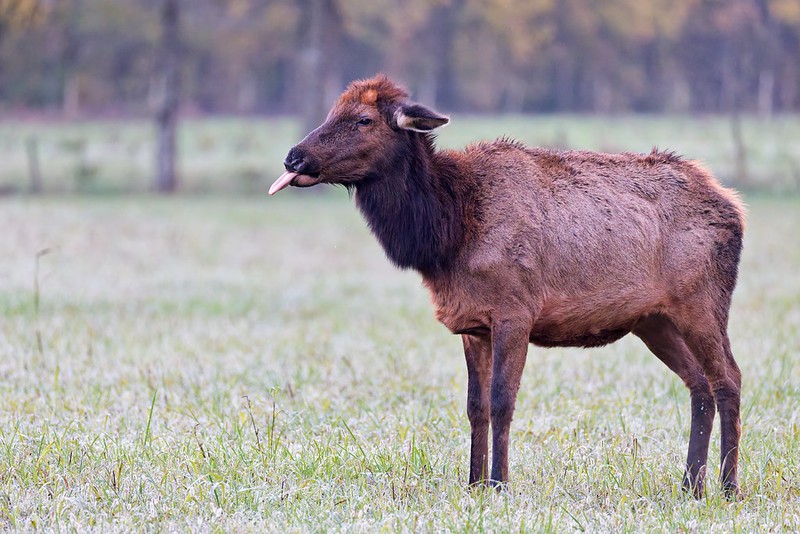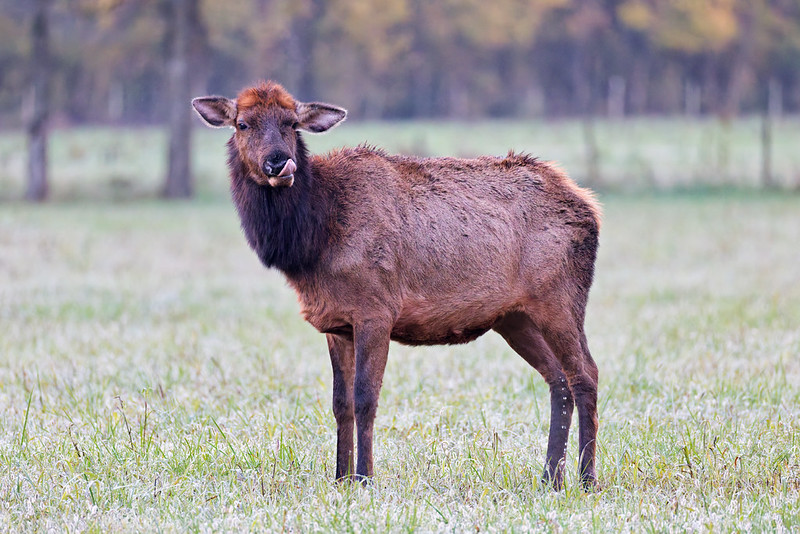I photographed this cow elk on a cool November morning in Boxley Valley, part of the Buffalo National River here in Arkansas. Light fog was drifting across the field when she stepped out of the herd and paused to lick her nose while urinating. The soft fog and the open pasture gave me a clean view of her. What caught my attention right away was the way she held her ears.

Both of her ears stayed low the entire time she walked around the pasture. Every other elk in the herd kept their ears up and active. This cow kept hers in the same relaxed, outward angle no matter what she was doing.
I watched her for several minutes. She grazed for a while, then eased forward through the grass. At one point she stopped and lifted her head to scent the air. Through all of this, her ears never lifted. The rest of her behavior looked normal. Her posture was steady. Her gait was clean. She stayed aware of the herd and the open field around her.
Wildlife Notes: Behavior of a Cow Elk With Drooped Ears
Elk use their ears like radar dishes. They pivot, scan, and turn toward sounds even when the head stays still. A healthy elk will rotate its ears almost constantly while walking or feeding.
A matched pair of low ears can show a relaxed state. Cows often drop their ears when everything feels calm around them. This usually changes the moment another elk calls or a sound breaks the quiet. The ears pop back up and start scanning again.
That is not what I saw with this cow. Her ears stayed down the entire time, even when other elk moved near her. She was aware of the herd and her surroundings, but the ear posture never changed.
Based on what I saw, I think she has old trauma to both ears. Elk can injure their ear cartilage when they tangle with brush, fight as calves, or deal with frostbite during a hard winter. Once the cartilage collapses, the ear often stays soft and low. When both ears match like this, the damage probably happened early in life.
If you want to see another moment from Boxley Valley, here is a recent post from the same area:
Spike Bull Elk Nuzzling Cow Elk in Boxley Valley.
What stood out to me is that she moved well and kept pace with the herd. Elk adapt to this kind of damage without much trouble. It does not seem to affect her feeding or her awareness. She looked healthy.
Photography Notes: Photographing a Cow Elk With Drooped Ears in Foggy Light
I photographed this cow elk from a distance as the fog lifted across the field. The soft light helped bring out the warm color in her coat. The fog also smoothed out the background, which made her stand out cleanly against the grass.
Gear and settings from this shot:
- Camera: Canon EOS R5
- Lens: Canon RF 200 to 800 mm F6.3 to 9 IS USM
- Focal Length: 800 mm
- Aperture: f/9
- Shutter Speed: 1/800 second
- ISO: 8000
- Exposure Compensation: +1/3
I stayed near the road and photographed from the edge of the pasture. The fog can make autofocus a little soft, so I kept the shutter speed high and let the ISO ride up. The long focal length helped isolate her even in low contrast conditions.

Note About This Cow Elk’s Coat and Ear Differences
While watching this cow, I also noticed that her coat looked a little rougher than some of the other elk in the field. The hair along her shoulders and flanks had more texture and did not lay as smooth as the nearby cows. Elk often show small differences like this during the fall coat change. Some finish their transition early, while others hold on to older hair a little longer. It can also reflect a bit of history, especially if an animal dealt with early stress or past injuries. She still moved well and looked healthy, and she stayed in step with the rest of the herd.
Closing Thoughts
This cow elk stood out from the rest of the herd because of her ears, but she seemed strong and steady. I always enjoy photographing wildlife that carries a bit of history. Animals like this show the marks of their past, and it adds another layer to the moment.

Steve, would she act like that if she could not hear? Just curious.
Thanks, Becky. If she couldn’t hear well, you’d usually see it in the rest of her behavior. Elk that have significant hearing loss tend to act jumpy, delayed in their reactions, or overly alert because they rely more on sight and scent. This cow moved right with the herd, reacted normally, and stayed aware of everything around her.
Because of that, I’m leaning toward old cartilage damage in both ears rather than a hearing issue. Everything else about her looked healthy.